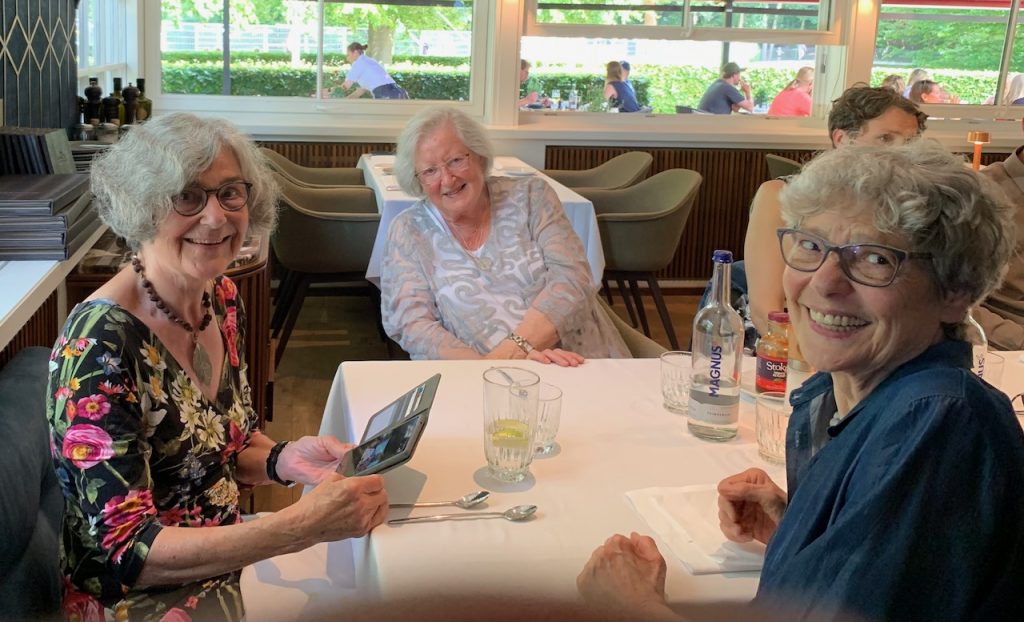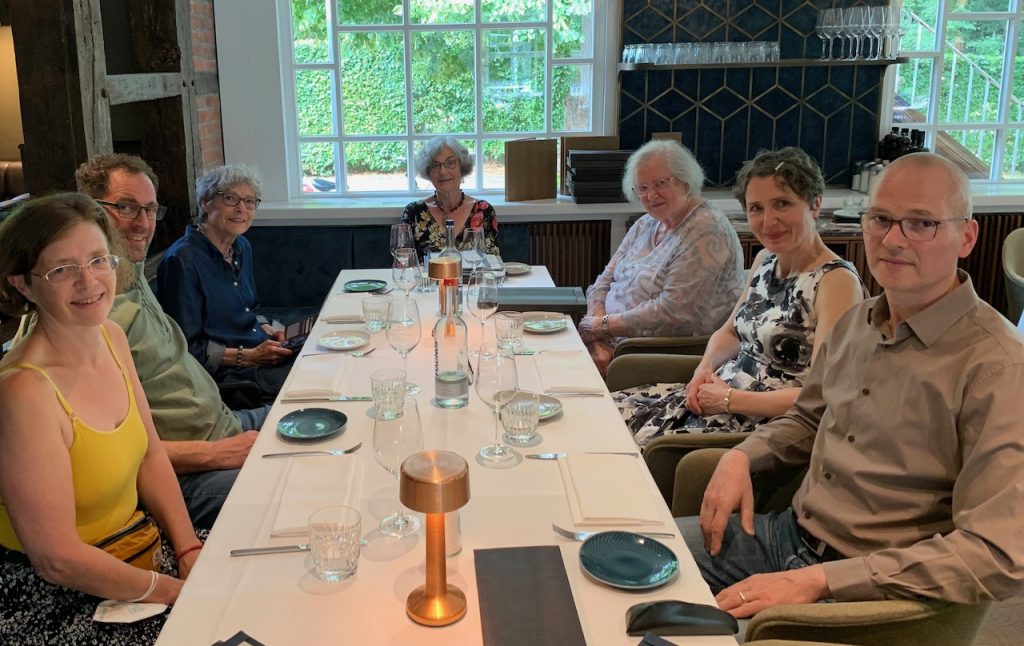Friday, August 19 and Saturday, August 20
On Friday, Mark TRIED to leave but only got as far as Heathrow Airport in London, where an extra security gate cost him his connection to Chicago. So while he, ever calm and not to be rattled, spent the night at an airport hotel (paid for by the airline, at least) after standing in line to get rebooked for LONG period of times, I hung out with Andrea. We went to a nearby second-hand store called Stilbruch, the first one I have ever been to in Germany that works on the Goodwill thrift store principle of donated goods benefiting a nonprofit (supporting the homeless, I believe), and I found some things for the grandkids that I hope are light enough to pack, and I got two more lovely meals at home–Greek salad at lunchtime and a lovely vegetarian lentil curry at night. Then it was time to meet my mom at the train station. Andrea was a total sweetheart and came along, so she could tell my mom happy birthday and help pull her suitcase to the nearby hotel where she and I stayed overnight (the neighborhood was somewhat sketchy and very crowded on Friday night, but the hotel itself looked very nice and clean and the room was surprisingly quiet, given how close to the ginormous central station we were!
On Saturday morning, I woke up early but stayed in bed and caught up on news and social media, so I wouldn’t wake up my mom. She slept until about 6:30. We stayed in bed a little while longer to talk, and then got ourselves ready for the day and went in search of a place to face breakfast. We ended up at the Hansaplatz, a plaza with some historic homes and an ugly monument in the middle, since there was a cafe with outdoor seating. We had coffee, croissants and a roll we split, and then went for a walk to the Aussenalster and through the nearby St. Georg neighborhood, which has some beautiful apartment buildings from the 1870s-1890s on broad boulevards that reminded me of “Haussman style” in Paris. After the throngs of yesterday, it was fairly quiet on a Saturday morning, as the streets were being cleaned and most stores were still closed. A nice little walk to start the day! I kept getting updates from Mark throughout the morning, even past the point when he was actually airborne–texting still worked even in the air.
We returned to the hotel around 10 am to check out and then made our way per S-Bahn to Poppenbüttel, about 20 minutes plus a 5-minute bus ride. This is where my aunt Frauke, my mom’s younger sister, lives, in an area of town slightly to the northwest of Andrea and Peter’s Wandsbek. I had never been to her lovely apartment, where she has lived for the past 8 years or so. She is very happy with her place and its location. All the shopping she needs is nearby and she lives right by yet another Hamburg park, where some of the locks that control water flow into the Alster create a little lake. Lots of large shade trees, water, footpaths everywhere–right outside her house. She walks here for an hour every morning, so we bonded over that. If I can still do that daily at 77 to start my day like she does, I will be very happy!
We sat on Frauke’s terrace surrounded by bushes and trees and chatted until the other guests arrived–my aunt Ute, who is 85, and her son Eric, who is a bit younger than I am. They both live nearby–she in a retirement community in an apartment (she has clearly slowed down a bit more than her younger sisters, and also has more health problems). and he in the rental apartment that his parents used to live in, and which he now shares with a roommate. My other cousin (Frauke’s son) and his wife had to cancel at the last minute–too bad because my mom and Martin share a birthday. Judith and Michael, who came into town by car, arrived around 12:30 and met us at the restaurant where we had lunch together. It was literally just across the street from my aunt, right at the Poppenbütteler Schleuse, the lock (hence its name: The Locks). We opted to sit inside (lots of open windows & ventilation, but no wasps, which are very plentiful right now) and had a lovely time at our late lunch–lots of laughter and family stories.

After taking a nice long time for lunch, we went for a short walk by the locks and by an arboretum with an ENORMOUS beech tree, and then it was already time for Imke to leave, so she could catch her train home. I had asked my cousin Erik to accompany her to the train station and get her to the platform, because I was yet again concerned about the crowds. She did get home ok, but with a bit of a delay, as we heard today. But it was a direct train and not a regional one, and she was fine.
Meanwhile, I had joined Judith and Michael and we drove to their place, with a quick stop to get groceries for the weekend, and after a quick dinner of bread and cheeses, we went for a very nice walk across nearby fields, and hung out for a bit and talked before we all turned in. Their place is so peaceful! So once I had heard from Mark that he had made it first to Denver I was able to settle down, although I was happy about the middle-of-the night text to confirm he had made it all the way home.
